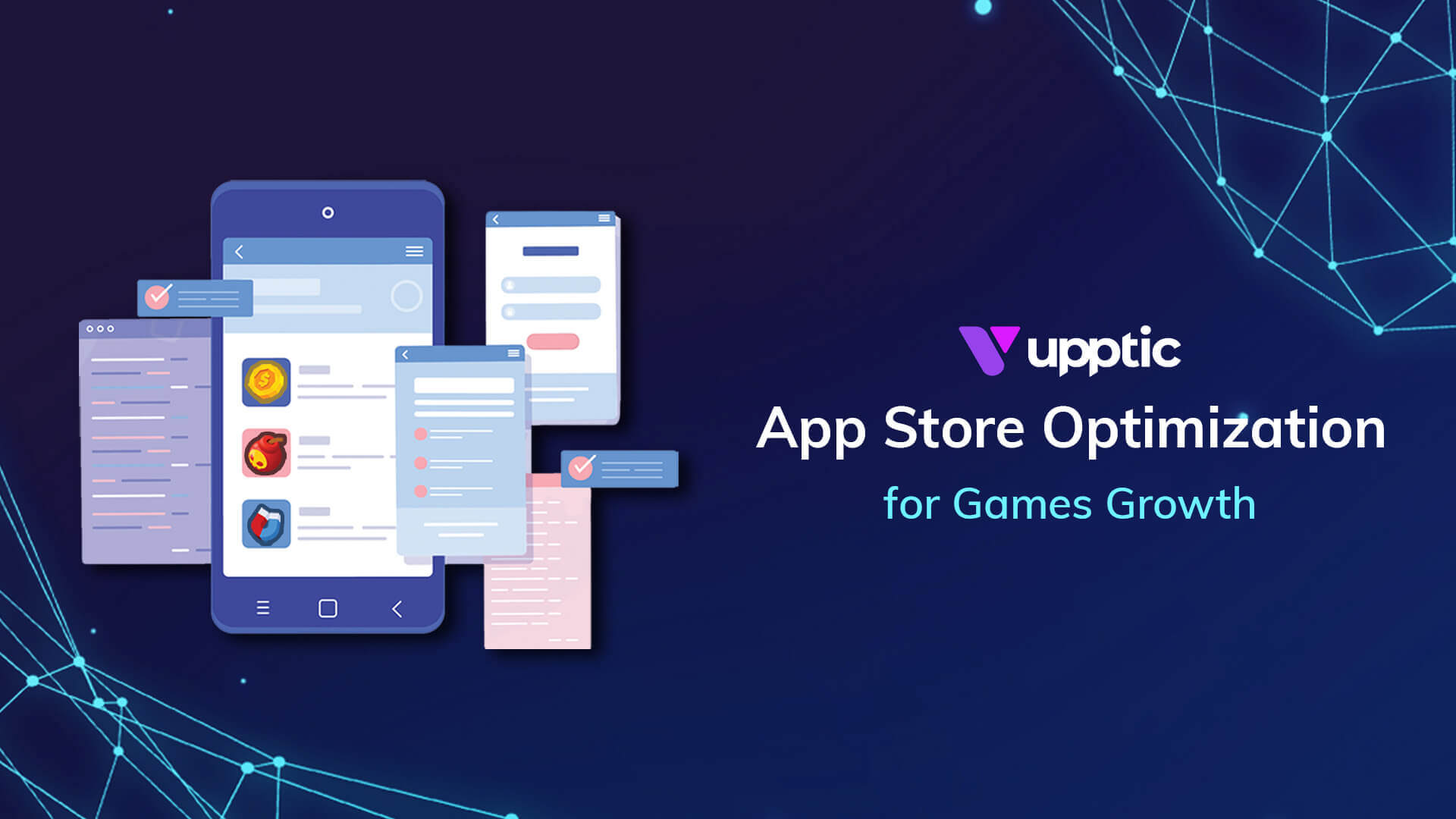Every game developer wants to increase their mobile game app game’s visibility in app stores. The better your game ASO, the better opportunity you have to drive sales for your game.
The primary purpose of an ASO strategy is to increase your app’s rankings and conversion rates in an app store – whether that be Android’s Google Play Store, the Apple App Store, Steam, the Epic Games Store, or another app store. No matter how good your game is, it will be hard to have massive success if you don’t have visibility and distribution.
Building a thoroughly optimized app store page is a lot of work. Fortunately, many specialized tools help optimize your marketing growth workflow, and Upptic offers the first fully automated ASO tool and platform.
Chapter Selector
- What app store optimization is – and why it’s important
- App Discoverability
- Conversion testing
- What to do before game development
- What to do before the game launch
- What to do at game launch and beyond
- Optimization: analyzing and iterating
- Tools and resources
What app store optimization is – and why it’s important
Think of app store optimization much like search engine optimization – but for an app store. ASO entails increasing your mobile game app’s visibility in digital stores (such as the Apple App Store, Google Play, Steam, etc.) by directing traffic to your games’ product pages and driving up the conversion rate to increase downloads.
Game ASO (app store optimization) highlights your game’s unique selling points and drives users to understand what to expect when they play your game. A good ASO strategy is critical for game developers to succeed in the mobile games space – and it’s important it’s done correctly.
App store optimization is generally broken into two categories, app discovery and conversion optimization testing.
App discoverability
App discoverability is how your app can be found in an app store. Most app stores allow you to search for specific keywords; therefore, optimizing your mobile games’ names and descriptions can increase your capacity to rank for a particular search term.
Conversion testing
Conversion testing is a specialized procedure that utilizes A/B testing to gauge how changes to a game’s product page increase its conversion rate. Conversion testing optimizes these product page elements to increase the probability of a user downloading the app or game.
App Discoverability
App discoverability is the ease or difficulty with which customers find your app or game. Key factors which drive discoverability include downloads, ratings, reviews, categories and keywords.
There are two primary vectors of discoverability: search and chart rankings.
- Chart rankings: Charts showcase the top mobile games in a given category (highest rated, most downloaded, etc.) or game genre (RPG games, simulator games, strategy games, etc.). As such, they’re highly impacted by downloads and user ratings. Your main aim is to climb these rankings until you reach the top of the charts.
- Search rankings: Searches are used by app store users to find items of interest. App stores use algorithms that detect your game’s keywords from different fields, namely, the app’s title, subtitle, and descriptions – ensuring they appear in relevant search queries. Therefore, these impact how you rank in searches. However, downloads and ratings also play a role in whether or not your mobile games come up in search results.
Let’s delve a little deeper into these impact factors.
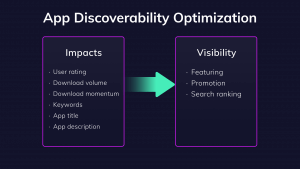
Downloads
Downloads are a critical part of improving your rankings across the app store. Here is a look at how app store optimization can increase your downloads.
How to increase your downloads using ASO (app store optimization)
Use a keyword tool like apptweak, keywordtoo.io or Apple Search to find relevant, high ranking keywords and use at least one in your game title. Keep your title concise and informative.
Use a hook to grab viewers’ attention and highlight the benefits of downloading your game. Additionally, make sure you are A/B testing elements like your game icon, description, trailer video, screenshots, etc.
Don’t underestimate the value of good customer service, either. It improves user experience, which usually generates good reviews.
How increased downloads will affect your ASO rankings
The best-ranking mobile games are the ones that accumulate the highest number of downloads in a shorter span of time. In other words, the quicker you get more downloads, the higher your ranking will be in an app store, which will lead to more traffic, and on and on.
Ratings and reviews
Ratings and reviews are critical both for appearing in top charts and for conversion – as great ratings make it more likely product page visitors will take the leap and download your mobile games. Let’s consider how you can improve your ratings.
How to increase your ratings
Positive ratings are best acquired by providing excellent user support and responding to your customer’s queries, complaints, and suggestions for improvement. Happy gamers love to share their joy with fellow enthusiasts.
Optimizing and debugging your app as soon as a problem is brought to your attention will make you a hero in the gaming world. A developer that is directly involved with and works in conjunction with its audience’s feedback is likely to go far.
In addition, many game developers will ask players to leave a good rating in the game’s app store through in-game notifications.
How better ratings improve your rankings
Ratings are a core part of reaching the top of many app store charts. The better your rating in an app store, the more likely it is to be seen. And the better the reviews are, the more likely prospective players are to download your game.
Categories
In most cases, your new game can fit into any one of numerous categories, and making the best choice isn’t always easy.
How to choose a category
When choosing your game category, you want one that will attract the maximum organic traffic while balancing for the littlest competition. This means you must identify the most popular categories your target audience will likely search for because categorizing is about directing the audience to your game.
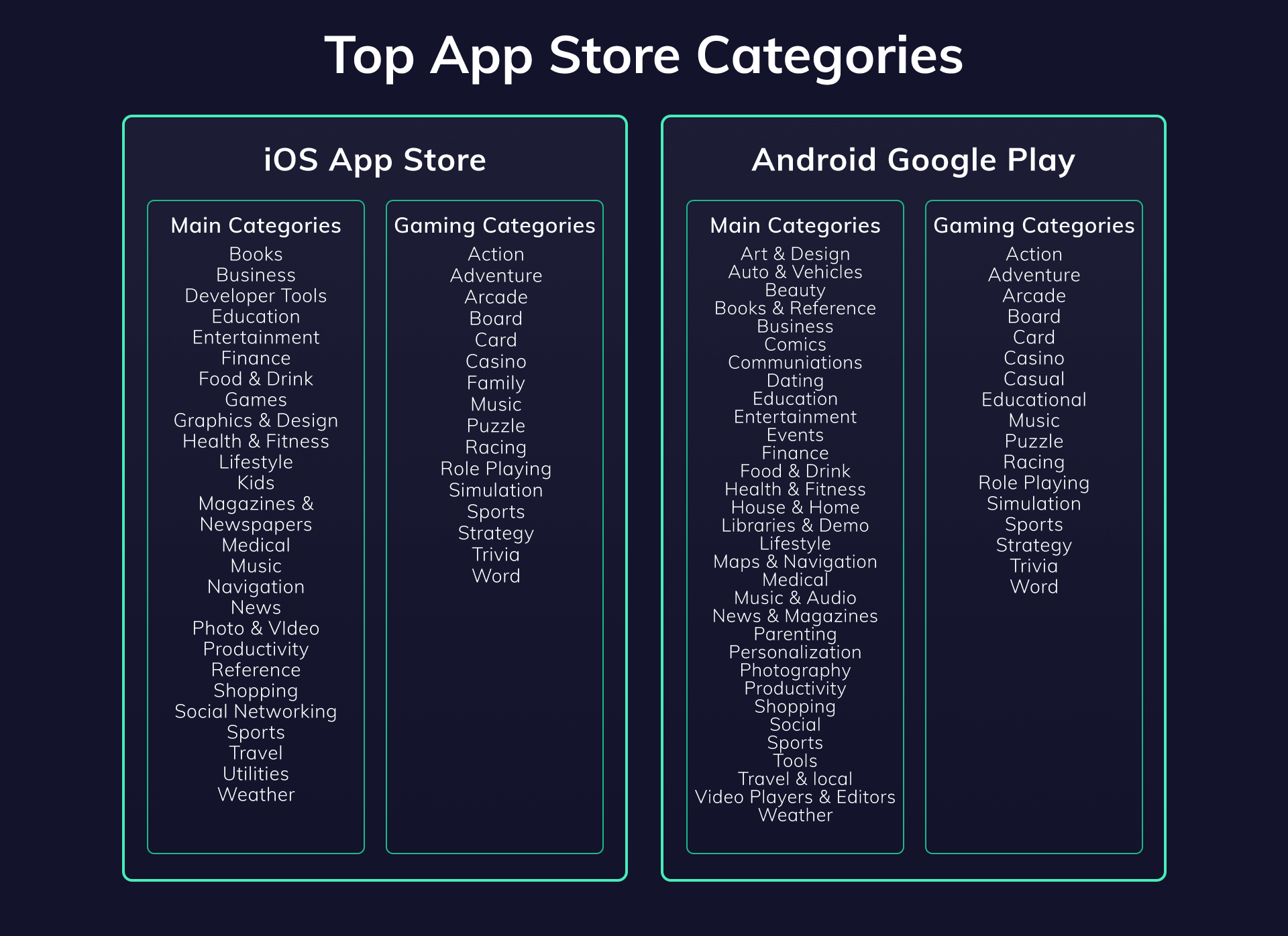
- Step into your user’s shoes: Try and tap into your target audience’s mindset and figure out what category they would place your game in. It’s not about what you think or feel but how the audience thinks.
- Check out competitor categories: Look at what categories similar games have been listed under. Potential customers will generally look under the same categories of other games they have enjoyed. That said, it’s also important to consider if there are categories with less competition that might work for your game as well.
- Understand the scope: In many app stores, games can choose up to two subcategories in addition to their main one – with dozens to choose from. You can typically change your category whenever it suits you, like when organic traffic slows down. You might also consider changing your category selection to try and break into a different market.
How category ranking affects discoverability
To use categories to your best advantage, you must grasp how they affect your app’s search rankings. When users browse and search by category, the primary category displays the app if the app is ranked. Users can also see where exactly the app ranks in its category.
Low-ranked apps do not feature well in searches unless there is a very clear alignment between the search keyword and the app. Organic traffic will be directed to the more popular apps, ranking higher in the primary category. Those in the top five or ten are more likely to be clicked. The better your ranking, the higher your visibility.
Some users don’t even bother to read the reviews if the category rating is high. They just download on the category merit. Therefore, choosing the correct category helps you reach your organic target audience.
Keywords
Keyword optimization is essential to ranking high on search engines, and intensive keyword research is necessary for this part of the operation.
How to select and test keywords
- Brainstorm: Write down as many keywords as possible that highlight your mobile game app content and description.
- Research: Research your main competitors and see what keywords they are using.
- Get into your audience’s thoughts: Try and think like your target viewer, anticipating which keywords they might search for.
How keywords affect rankings
If you’ve been wise with your keyword research, you will have anticipated the keywords your target audience will search for and your rankings will be higher in search queries.
Conversion testing
Conversion testing is the use of A/B tests to ascertain which mobile game app product page features are more likely to lead to downloads – thereby increasing conversions.
Typically, the most common way to run a conversion test is to set up two product page variants and analyze their performance manually. Recently, both Apple and Google have released native conversion testing products, but neither features particularly effective or efficient performance.
Instead, for those wishing to iterate quickly and efficiently, it’s best to look toward ASO providers such as Upptic or Storemaven. These companies offer automated conversion testing tools – allowing game developers and marketers to maximize profitability quickly.
Let’s look at the key components that should regularly undergo conversion testing.
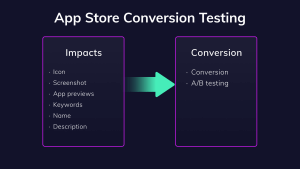
Game app icon
![]() Your game app icon is the first visual impression a viewer has of your product and is the only creative marketing asset that appears on the search results page – making it one of your most important visual assets.
Your game app icon is the first visual impression a viewer has of your product and is the only creative marketing asset that appears on the search results page – making it one of your most important visual assets.
App design principles
Here are some basic principles to help you design the best game app icons for your brand:
- Visibility: You want your app icon to be striking and easily recognizable.
- Scale: Consider the design scale and keep it simple.
- Consistency: Your app and your app icon should work in harmony.
- Distinctiveness: Check out your competitors and do something different.
- Limit text: Your app icon should be easily recognizable without the viewer having to read more than a word or two.
How to A/B test your app icon
If you’re not using fully automated tools, these are the steps you need to do a manual conversion test of your game app icon:
- Hypothesis: Choose a solid idea to test, like testing one icon with text and one without to compare the results.
- Design: Design different versions of your icon based on the theory you have chosen to test.
- Run your test: Set up the different icons with variant pages so they can be seen in your app stores of choice.
- Direct traffic: Ensure a steady amount of traffic so you can get statistically significant results.
- Analyze and optimize: After collecting figures and data, carefully analyze the results and make a decision based on the optimal icon that has emerged.
- Repeat: These tests must be done regularly to keep ahead of the marketplace and your competition.
Game app name / game app title
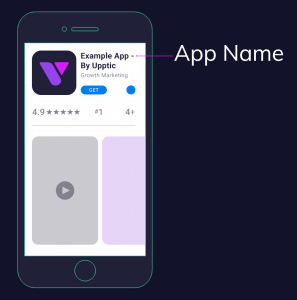 Your game app name, or game app title, is the official name of your game as it appears in an app store. In most app stores, game app titles must be short as they are typically restricted to a limited number of characters.
Your game app name, or game app title, is the official name of your game as it appears in an app store. In most app stores, game app titles must be short as they are typically restricted to a limited number of characters.
Best practices
These are the essential things to bear in mind when it comes to great game app titles:
- Make sure your title is discoverable: Make sure you use a primary keyword in your title to create better visibility and rankings.
- Create your brand: Your game app title is not just a name for your product. It is your brand. Be proud, be loud, and boost your brand.
How to A/B test your game app title
Developers don’t always have to do things the long way around. This is a quick and easy cheat to get a quick heads-up on your game app title. Here is a three-step testing process to easily and effectively test your App title:
- List in other countries: Add your store listing in several other same-language-speaking countries.
- Alternate titles: Put an alternate title in each of the localized store listings. This way, you can test numerous titles simultaneously, with minimal risk, because you are experimenting with smaller groups.
- Measure performance: Utilize acquisition reports to analyze results before changing your title.
Game app subtitle
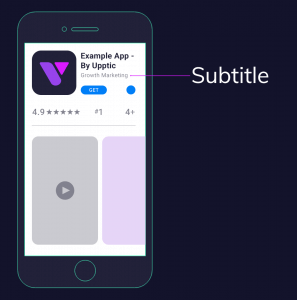 Your game app subtitle is an additional description to your game app title and is displayed underneath it. Having a compelling hook for your subtitle can encourage more conversions, which can ultimately impact your rankings as well.
Your game app subtitle is an additional description to your game app title and is displayed underneath it. Having a compelling hook for your subtitle can encourage more conversions, which can ultimately impact your rankings as well.
Best practices
Here’s how to get the best success from your game app subtitle:
- Keyword optimization: Your game app subtitle affects your search ranking depending on how effective your chosen keywords are.
- Regular conversion testing: Even though your subtitle doesn’t have a heavy visual impact, it still affects your conversion rate, so don’t neglect to test it along with your screenshots and other creative assets.
- Highlight benefits: Use your app subtitle to promote the perks of your game to viewers.
How to conversion test your app subtitle
Conversion testing is all about which variables will improve your conversion rate. Your app subtitle contains keywords and lists your app’s essential promotional points. Your job with conversion testing is determining which factors will most likely attract new customers and increase your organic traffic by perking the viewers’ interest.
- Research: Research your competitors and see what the higher ranking game app subtitles display.
- Keywords: Try listing different benefits to attract a new group of viewers searching for different things.
Video previews
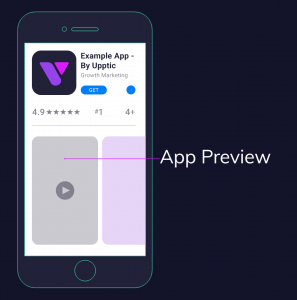 Video previews are one of your app or game’s most impactful visual assets. Essentially a promotional trailer, video previews show viewers what the game looks like in action. Keep in mind though that this is not an ad, so don’t display prices. Instead, highlight your game’s perks and reasons prospective players should download it.
Video previews are one of your app or game’s most impactful visual assets. Essentially a promotional trailer, video previews show viewers what the game looks like in action. Keep in mind though that this is not an ad, so don’t display prices. Instead, highlight your game’s perks and reasons prospective players should download it.
Best Practices
A good preview video can drastically increase conversions. Let’s walk through some of the best video preview practices for game ASO.
- Don’t waffle: Start your video by jumping straight to the main point in the first few seconds.
- Avoid repetition: State your point clearly and quickly so it has maximum impact, and avoid boring your viewers with useless repetition.
- Localize your video: Make the most of your App’s distribution potential by targeting several countries in their native languages.
How to conversion test your video preview
Your game app’s video preview is one of your most powerful marketing tools. Optimize conversions by conducting intensive conversion testing.
- Test optimal video quantity: Some app stores allow you to upload multiple videos. Where you can, test your game app’s conversion rate first with no video, then with one, and, finally, multiple videos. Surprisingly, some game apps have better conversion rates without using a preview video.
- Segment your video: Split your video into definite, different parts, with each segment focusing on a different feature. When analyzing your data, you can see which component drives more conversions.
- Test video orientation: Find the best display mode by testing landscape, portrait or a mix of both orientations to gauge how to get the best effects of layout and clarity for your product page.
Screenshots
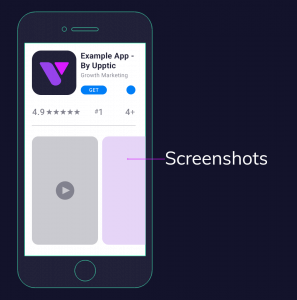 Screenshots are visual assets which show gamers quick snapshots of your game, allowing them to quickly judge things like user interface and quality of graphics. As such, good game app screenshots are crucial for driving up your game app’s conversion rate. Your screenshots will impact every viewer that comes to your product page. If you optimize them correctly, you can entice many viewers to download your game.
Screenshots are visual assets which show gamers quick snapshots of your game, allowing them to quickly judge things like user interface and quality of graphics. As such, good game app screenshots are crucial for driving up your game app’s conversion rate. Your screenshots will impact every viewer that comes to your product page. If you optimize them correctly, you can entice many viewers to download your game.
Best Practices
Follow these guidelines to get the most out of your optimization:
- Research: Every optimization aspect should begin with research, particularly analyzing higher-ranking competitors with game apps in the same or similar categories.
- Orientation: Research shows that landscape shots impact viewers more and are more likely to entice them to click on a product page or make a direct download.
- Focus: Include shots of gameplay, menus, features, etc. Give would-be players a good idea of the different aspects of your game.
How to conversion test your screenshots
Your screenshots can make or break your game’s store page, as it’s one of the first things potential players will see and react to. But figuring out what screenshots will hook your target audience is not a guessing game.
Analyzing the conversion rate of this particular element is worth every penny you put into it. Well-optimized screenshots can easily result in downloads if your viewers fall in love at first sight.
- Competitive research: As with all aspects of ASO, research higher-ranking competitors for tips and lower-ranking competitors to avoid making the same mistakes.
- Orientation: While landscape shots tend to impact viewers more, it’s still important to iterate on screenshot orientations – especially if your game is played in portrait mode.
- Focus: While you definitely want to provide a variety of screenshots to showcase your game, iterate on what you are showing and the order you are showing them in to see what players are latching on to.
Description
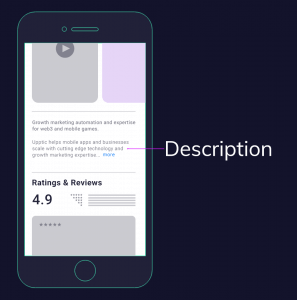 The description describes what your game is about and should contain relevant keywords. The role of the description is to convince the “hard-to-sells” that your game is worth downloading.
The description describes what your game is about and should contain relevant keywords. The role of the description is to convince the “hard-to-sells” that your game is worth downloading.
So your description, especially the first few lines, needs to be your hook and have an impact on the viewer. After the first few lines, the viewer must press “see more” to read on.
Best Practices
The description has a different purpose in the Apple App Store compared with the Google Play Store, and each store has different guidelines. Additionally, some stores also have a “short description” feature.
The Apple App Store
The description doesn’t affect algorithms on the Apple App Store, and keywords from this description are neither indexed. The primary purpose of this description is to sell the game to viewers who haven’t been convinced yet.
The Google Play Store
The long description ranks your game partly by taking any keywords into consideration. It is an essential factor in algorithms.
- Use primary keywords more than once: Repeating important keywords once or twice can improve your ranking but beware of keyword stuffing.
- Use natural language: Algorithms respond better to natural-sounding sentences, and so does your audience.
- Be informative: Your description should be structured and understandable, providing clear information on your game’s highlights.
- Include a strong CTA: You can be creative, using emojis, for instance.
How to A/B test your description
The easiest way to split-test your long description on the Play Store is to use the Google Play Console to conduct your experiments. These will generate results for you to analyze to improve the traffic to your product page and drive up your conversion rate.
Promotional text
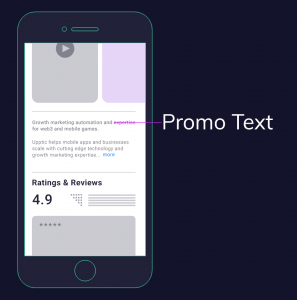 As the name suggests, this text is designed to promote and advertise holidays, sales and events. Promo text can be updated at any time without revamping your entire app. While it is not indexed for keywords, it’s still an essential part of ASO. It does not affect your rankings but can effectively drive up conversion rates. However, it is an optional feature that can be omitted if the developer chooses.
As the name suggests, this text is designed to promote and advertise holidays, sales and events. Promo text can be updated at any time without revamping your entire app. While it is not indexed for keywords, it’s still an essential part of ASO. It does not affect your rankings but can effectively drive up conversion rates. However, it is an optional feature that can be omitted if the developer chooses.
That said, here are a few benefits of including promotional text.
- Use as a hook: Use compelling and persuasive words that evoke strong emotions and a desire to click through to your product page.
- Keeps users updated: Being able to edit your text at any time means that customers are always kept in the loop. Inform them of bug fixes, pending events, sales, and new features. Users will always be in the know if you keep your promo text updated.
- Increases downloads: The right combination of words can spark a desire for the viewer to own your apps. If your promotional text is powerful enough, it can encourage viewers to download on the strength of a few sentences alone.
- Use as a feedback tool: Inform users that you are working on fixing that bug they’ve been struggling with, for instance. Users love to feel that their requests are essential to them.
- Improves ASO: Increased downloads will boost your rankings, thus improving your ASO and visibility and driving up your conversion rate.
Interestingly, the promotional text is displayed above the long description on a mobile device after an organic search. Still, the promotional text must be shown if a viewer uses a web browser to access the app listing.
Best Practices
Promotional text is limited, but can effectively hook people. Your promotional text should have an enormous impact as a magnet for the target audience. Here’s how to create promotional text for maximum success:
- Be clear and concise: Keep it short and to the point. Ensure that it is easy to understand.
- Research keywords: As with every conversion component, you need to carefully check out competitors and keyword tools to find the most effective keywords and phrases.
- Keep it conversational but relevant: Use language familiar to the target group. Technical jargon can intimidate some viewers, causing them to simply scroll past your app.
- Highlight benefits: Summarize and highlight valuable features, promotions, and sales of your app.
How to A/B test your promotional text
Promotional text is different from the other elements that affect your conversion rates. It can be updated daily and directly linked to upcoming events, sales, promotions, or other timely topics surrounding your product. Most of these snippets of content are definite and fixed details that cannot be changed to suit viewer preferences.
For instance, if you are introducing a new feature and offering a sales promotion with a 25% discount, you have just a few lines of text to work with. Understanding your target audience and identifying which announcement will have more impact and in what order is the way to gain success.
Test and iterate on what you put in the promotional text and in which order you highlight things. Then, Pay close attention to what your audience comments on and what drives conversions.
This will allow you to anticipate your target audience’s reaction to your promotional texts. You will also develop a particular style of promotional texting that works best for this niche. The great thing about promotional text is that it is fluid because it can be changed without delay or fuss.
Ratings and reviews
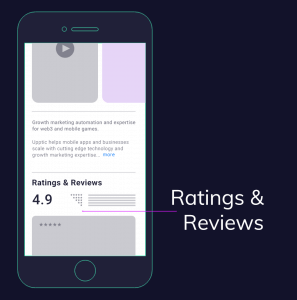 App ratings and reviews are huge factors when it comes to driving up your conversion rate. The challenge comes with the fact that this is the only feature of your product page that is entirely user-driven. You cannot put words into your audience’s mouths without being unethical and risking your app being banned in app stores.
App ratings and reviews are huge factors when it comes to driving up your conversion rate. The challenge comes with the fact that this is the only feature of your product page that is entirely user-driven. You cannot put words into your audience’s mouths without being unethical and risking your app being banned in app stores.
Best Practices
When coming across an app for the first time, most users look at the rating, usually composed of five stars, before anything else. In the gaming industry, word of mouth is a great motivator, so it is worth your while to do extra legwork to collect customer feedback.
However, a savvy developer knows that it’s not the feedback that matters but how it helps the developer close the gap between user expectation and user experience. You can expect your conversion rate to rise when user experience equals or exceeds user expectations.
Being a user-driven feature means you don’t create your reviews – your customers do. Here are a few ideas to consider.
- Interactive promotional text: Communicating with users through regularly updated promotional text can set user expectations and improve user experiences, leading to better ratings and reviews.
- Respond to feedback: Customers who are heard are happy, and satisfied customers leave good reviews.
- Rating prompts: have a rating prompt pop up at an appropriate time in-game, such as after completing a level.
- Offer incentives: Offering incentives like free lives or in-game currency for ratings and reviews is a good way of motivating a customer to rate your games and leave a review.
How to A/B test your ratings and reviews
Because the ratings and reviews section on your product page is entirely user-driven, there is no real way to split-test it. The best practice for getting good results is to ensure that if you can’t solve your user’s problem, you answer or acknowledge negative reviews. This shows the user that their feedback and experiences matter.
What to do before game development
Before you start coding your games or building assets, you should already be thinking about game ASO. In particular, you should be researching and thinking deeply on your mobile game app’s genre, target audience, and competitors.
Deciding on a game genre
Until your game is well-known, you’ll be relying largely on paid traffic for your downloads. To ensure you’re not wasting your ad dollars, it pays to figure out what gamers are interested in most – and what niches may be underserved.
Consider these factors when selecting your genre:
- Mass appeal vs. niche representation: On the one hand, a game in a popular genre might seem easier to build success on. However, a game in a niche category with less competition might be more easily seen in an app store and more readily downloaded.
- Research: Take a look at games in the “rising” or “viral” categories in the app stores you’re on. Building a game in a category gaining steam can put you ahead of the rest of the pack.
Ultimately, it can pay to build a game around underserved categories instead of simply finding which category best suits the game you’ve already built.
Identifying a target audience
Going hand-in-hand with selecting a genre is identifying a target audience. Audiences that are underserved can be ideal groups to build games for. These are people who want to game, but don’t have many options when it comes to the way they like to game or the kinds of games they like.
This means there will be less competition for their time and money and a higher chance of conversion simply through virtue of them having limited options.
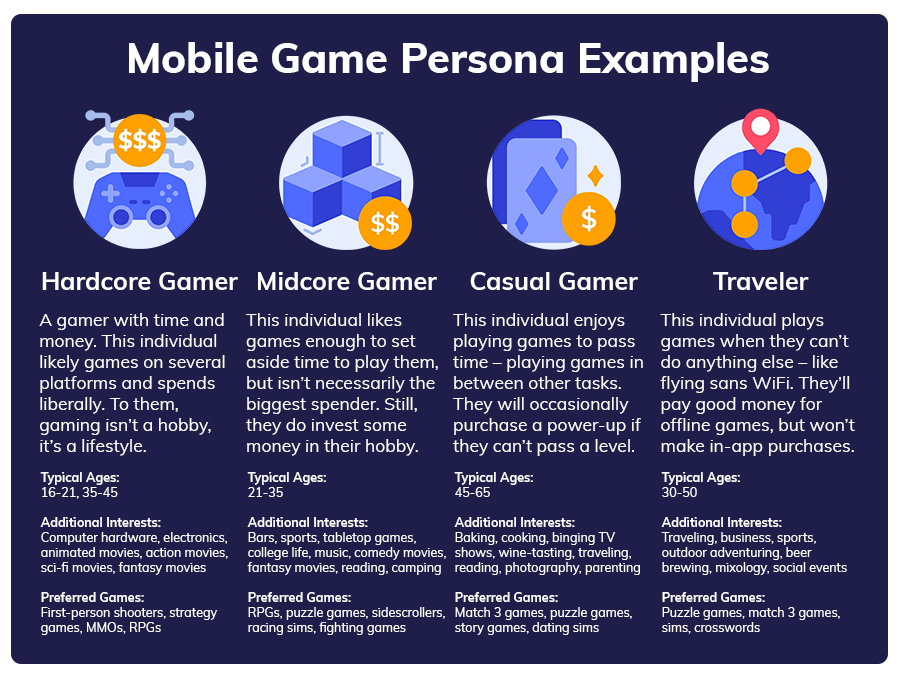
Understanding the competition
If your game is to have any success, it needs to withstand the competition, and you can only do so by understanding who your competition is. These are some of the factors to consider when doing competitive analysis:
- Choose your core competitors: Your core competitors offer the same or a very similar service and target the same audience. Mitigate the competition by focusing on areas that most other game developers aren’t focusing on.
- Analyze strengths and weaknesses: Visit your top competitors’ product pages and check out their key game elements, like mobile game app title, icon, screenshots, ratings, reviews, etc., to discern what you should and shouldn’t do when building your own game.
What to do before game launch
Once your game is nearing completion, it’s time to start prepping your mobile game app for app stores. That means it’s a good time to research keywords and make sure you’re following metadata best practices.
Keyword research
Once you’ve developed your game you can begin the work of associating it with keywords. Consider the genre, mechanics, themes, and style when coming up with keywords. Take a look at who your most successful competitors are and the keywords they seem to be using, and research what your target audience is looking for.
Metadata best practices
Metadata is the informational data about a game app. For instance, visual metadata will include your screenshot and textual metadata, your game app title and your description. The data must be user- and search-engine friendly to boost your discoverability and conversion rate.
These are the best practices for effective metadata:
- Remain fluid: Keep your ASO alive by constantly feeding it new metadata. As the market changes, you need to update your information so that your competitors stay caught up.
- Keep it simple: Avoid clutter in your screenshots and use impactful and short textual messages to get your point across. Make it easy for the viewer to see what your game is about at first glance.
- Target long-tail keywords: With a new game, competitive, high-traffic keywords are not always the best choice. Try to find relevant long-tail keywords and medium-size search volume keywords. In the beginning, it will be easier to break into the market and get higher rankings with these types of keywords.
What to do at game launch and beyond
So you’ve launched your game, now what? This is where your marketing really takes off. There are a few very important factors that comprise an effective game launch marketing campaign. Your focus at this stage will be paid marketing and ensuring it leads to organic uplift.
Paid marketing
Paid marketing campaigns are essential for making initial inroads to top charts and increasing visibility of your game in general. Here are some good practices for efficient marketing.
- Variety is the spice of life: Make sure you’re using a variety of ad formats on a variety of platforms. That said, it’s good to focus most of your efforts on more engaging ads – such as video ads, rewarded ads, and playable ads.
- Don’t be everywhere: Your ideal players likely congregate in a few key places. Instead of wasting time, resources, and money by being on all platforms, find a few of the top social media platforms and websites they tend to be on and focus your efforts there.
- Use shorter payback windows: While it can be enticing to extend payback windows if you’re not hitting your marketing goals, it’s also a red flag of money waste. Rather than extending your payback windows, work on improving your marketing efficacy and efficiency.
If you hit the right notes in your paid marketing strategy, you’ll reap the rewards not only in initial downloads, but also in organic uplift.
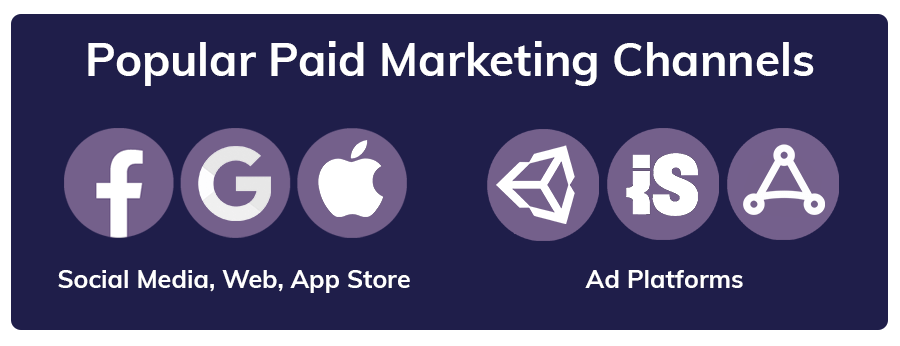
Organic uplift
When people see your ads and download your game, it starts to rise up the charts in app stores and people begin talking about the game online. When others then see your game in the app store charts or on social media posts, and go and purchase the game as well, this is organic uplift.
The purpose of organic uplift for ASO is to get your game to rank higher and increase downloads. It has a direct influence on raising your discoverability in an app store and across the web. In general, organic growth is the best growth because it costs significantly less than paid campaigns do and has a longer tail.
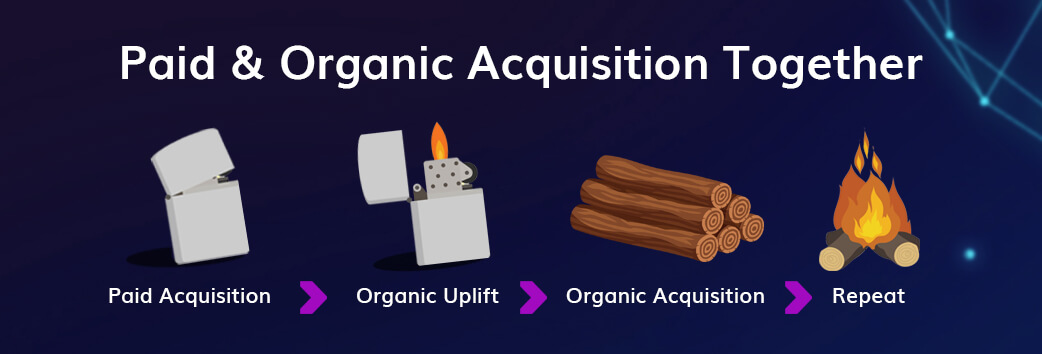
Optimization: analyzing and iterating
Paid marketing, organic uplift, and app store optimization do not live in silos or vacuums. They are all interconnected and must be continually refined through analysis and iteration.
Analyzing
Analytics are essential because they help you understand user behavior. This can help you identify pain points within your conversion funnel. If you see that prospective players are dropping off your funnel at a certain point, you can focus efforts there. Additionally, analytics are important for gauging the efficacy of split-tests and iterating appropriately.
Iterating
Iteration is an adaptive process that helps marketers to fine-tune their ads, creatives, product page assets, and more. There are four stages to the iteration process, namely:
- Concept: A new creative or asset change is proposed.
- Prototyping: This is a usable version of the envisioned creative.
- Testing: The creative is used in small-scale tests or split-tests.
- Evaluation: Analytics from the testing stage are reviewed and, based on performance, a decision is made to keep or discard the proposed creative or change.
Whether or not the new creative or asset change is ultimately implemented, the process of analysis and iteration should continue for both for the component tested and all other creatives and app store product page assets.
Optimization
Ultimately, optimization is a process. Not a goal or destination. In order to ensure your app store product page is always “optimized”, you should audit and update it on a regular basis – at least annually, but every few months is even better.
It’s a fact that the more you optimize, the better your chance at success is.
Tools and resources
Given that game app store optimization is a continuous process that requires a deep understanding of data and the ability to iterate quickly, tools and other resources will be a necessity.
Many app stores provide rudimentary analytics and other tools. Google Search Console, while meant for your website, can assist with identifying keywords that your audience is likely to find you with.
However, given all the infrastructure and expertise required, no good holistic solution exists outside of mobile game growth agencies like Upptic.
If you’re ready to grow your game through effective app store optimization, contact us today.

